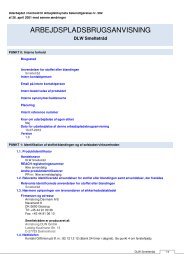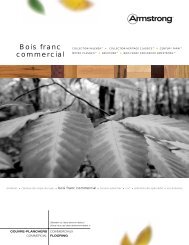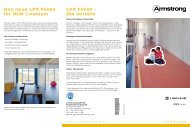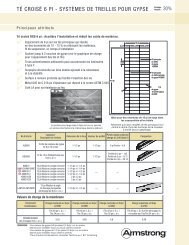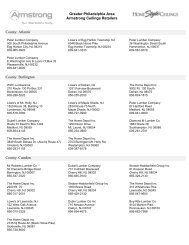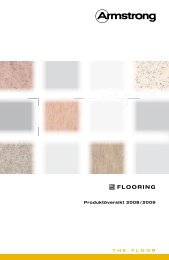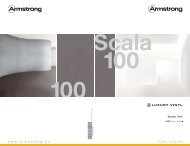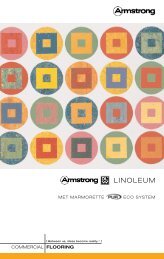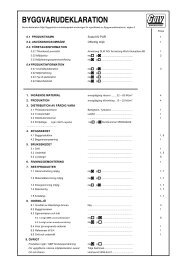installation [pdf] - Armstrong
installation [pdf] - Armstrong
installation [pdf] - Armstrong
You also want an ePaper? Increase the reach of your titles
YUMPU automatically turns print PDFs into web optimized ePapers that Google loves.
WALL BASE, RISERS, and Vinyl<br />
TRANSITION STRIPS<br />
Installation System<br />
Product Gauge Size Adhesive<br />
WALL BASE - Vinyl<br />
WALL BASE - Vinyl<br />
WALL BASE - Rubber<br />
0.080"<br />
(2.0 mm)<br />
1/8"<br />
(3.2 mm)<br />
1/8"<br />
(3.2 mm)<br />
RISERS 1/8"<br />
(3.2 mm)<br />
TRANSITION STRIPS<br />
2.5" x 4" (6.35 cm x 10.16 cm)<br />
4" x 4" (10.16 cm x 10.16 cm)<br />
4" x 160' (10.16 cm x 48.77 m)<br />
6" x 4' (15.24 cm x 1.22 m)<br />
2.5" x 4" (6.35 cm x 10.16 cm)<br />
2.5" x 120' (6.35 cm x 36.58 m)<br />
4" x 4" (10.16 cm x 10.16 cm)<br />
4" x 120' (10.16 cm x 36.58 m)<br />
4" coved external corners (10.16 cm)<br />
6" x 4' (15.24 cm x 1.22 m)<br />
6" x 96' (15.24 cm x 29.26 m)<br />
2.5" x 4" (6.35 cm x 10.16 cm)<br />
4" x 4" (10.16 cm x 10.16 cm)<br />
4" x 120' (10.16 cm x 36.58 m)<br />
4" coved external corners (10.16 cm)<br />
6" x 4' (15.24 cm x 1.22 m)<br />
7" x 48' (17.78 cm x 1.22 m)<br />
7" x 72' (17.78 cm x 1.83 m)<br />
Various Sizes and Shapes<br />
S-725 Set-in-Wet<br />
Solvent-Based<br />
Contact Adhesive<br />
Installation:<br />
Location:<br />
All grade levels<br />
Suitable Substrates:<br />
All clean, dry, smooth, and structurally sound surfaces, including gypsum<br />
drywall, plaster, concrete, plywood, paneling, masonry, steel, stainless steel,<br />
and aluminum.<br />
NOTE: WALL BASE should not be installed on below-grade outside walls<br />
if moisture or alkali is present. Do not install over nonporous surfaces<br />
such as vinyl wall coverings and nonporous paints. If in doubt of porosity,<br />
abrade the paint or run a bond test. Wall coverings and nonporous paints<br />
should not extend more than 1/2" (12.7 mm) below the top of the base.<br />
Exterior use is not recommended.<br />
Job Conditions/Preparation:<br />
• Resilient flooring should only be installed in temperature-controlled<br />
environments. It is necessary to maintain a constant temperature before,<br />
during, and after the <strong>installation</strong>. Therefore, the permanent or temporary<br />
HVAC system must be in operation before the <strong>installation</strong> of resilient<br />
flooring. Portable heaters are not recommended as they may not heat the<br />
room and subfloor sufficiently. Kerosene heaters should never be used.<br />
4. 96<br />
Chapter IV — Installation Systems
• Surfaces must be dry, clean, smooth, structurally sound, and free from<br />
moisture, alkali, dust, dirt, wax, oils, grease, loose paint or plaster, wall<br />
coverings, or any other foreign matter.<br />
• In renovation or remodel work, remove any existing adhesive residue* so<br />
that no ridges or puddles are evident and what remains is a thin, smooth<br />
film. Rough or uneven wall surfaces may telegraph through the WALL BASE.<br />
• Allow all materials and adhesives to condition to the room temperature for a<br />
minimum of 48 hours before starting the <strong>installation</strong>.<br />
• The area should be maintained at a minimum of 65°F (18°C) and a<br />
maximum of 100°F (38°C) for 48 hours before, during, and for 48 hours after<br />
completion.<br />
• During the service life of the floor and WALL BASE, the temperature should<br />
never rise above 100°F (38°C) nor fall below 55°F (13°C). The performance<br />
of the flooring material and adhesives can be adversely affected outside this<br />
temperature range.<br />
Precautions:<br />
• Do not install WALL BASE on below-grade outside walls if moisture or alkali<br />
is present.<br />
• Do not install WALL BASE over vinyl wall coverings and nonporous paints.<br />
Fitting for WALL BASE and RISERS:<br />
Avoid small pieces at inside and outside corners. Pieces should be no less<br />
than 4" (10.2 cm) in length on both sides of the corners.<br />
WALL BASE can be mitered or formed and wrapped around outside<br />
corners. Shave a strip approximately 1/4" (6.4 mm) wide and one quarter<br />
of the thickness from the back of the WALL BASE where the corner will be<br />
positioned. This will reduce the thickness to make bending around the corner<br />
easier and neater. Do not cut behind the coved toe.<br />
WALL BASE can be mitered, scribed, or wrapped with a V-shaped notch in the<br />
toe at inside corners.<br />
Fitting should be completed for each piece before applying adhesive.<br />
WALL BASE Procedure:<br />
1. For straight wall sections, apply the S-725 Adhesive to the back of the<br />
WALL BASE or directly to the substrate using a WALL BASE notched<br />
spreader. Stay 1/8" (3.2 mm) away from the top of the WALL BASE to<br />
prevent adhesive oozing.<br />
2. Apply a solvent-based contact adhesive to outside corners using a 2" (5.1<br />
cm) brush or a very fine notched trowel. Apply a minimum of 4" (10.2 cm)<br />
from the outside corner, on both sides of the corner and to the back of<br />
the WALL BASE. When using contact adhesive, always follow the cautions<br />
and warnings on the can.<br />
* Some previously manufactured asphaltic “cutback” adhesives contained asbestos (see warning<br />
statement on page x). For removal instructions, refer to the Resilient Floor Covering Institute’s<br />
publication Recommended Work Practices for Removal of Resilient Floor Coverings.<br />
Chapter IV — Installation Systems 4. 97
3. If using a cartridge, apply two 1/8" (3.2 mm) beads to the back of 2-1/2"<br />
(6.4 cm) base, three beads to 4" (10.2 cm) base, and five beads to 6" (15.2<br />
cm) base and 7” (17.8 cm).<br />
4. Heating the WALL BASE from the back will help it conform at outside<br />
corners.<br />
5. After applying S-725 Adhesive, place WALL BAES into position on the wall.<br />
6. Butt joints neatly and roll with a hand roller toward the previously<br />
installed section for a tight fit.<br />
7. Follow the above steps until the <strong>installation</strong> is completed.<br />
RISER Procedure:<br />
1. For straight wall sections, apply the S-725 Adhesive to the back of the<br />
RISER or directly to the substrate using a WALL BASE notch spreader.<br />
Stay 1/8" (3.2 mm) away from the top of the RISER to prevent adhesive<br />
oozing.<br />
2. After applying S-725 Adhesive, place RISER into position.<br />
3. Butt joints neatly and roll with a hand roller toward the previously<br />
installed section for a tight fit.<br />
4. Follow above steps until the <strong>installation</strong> is completed.<br />
TRANSITION STRIP Procedure:<br />
1. Subfloor must be smooth, sound, dry, clean, and free of dirt, wax, polish,<br />
paint, and all other foreign matter which may interfere in a good bond,<br />
including curing agents and sealers.<br />
2. Carefully follow warnings on container of the Solvent-Based Contact<br />
Adhesive. Follow adhesive manufacturer’s recommendations for the<br />
<strong>installation</strong> of TRANSITION STRIPS.<br />
3. Roll TRANSITION STRIP with a hand roller.<br />
4. 98<br />
Chapter IV — Installation Systems


![installation [pdf] - Armstrong](https://img.yumpu.com/21989817/1/500x640/installation-pdf-armstrong.jpg)
